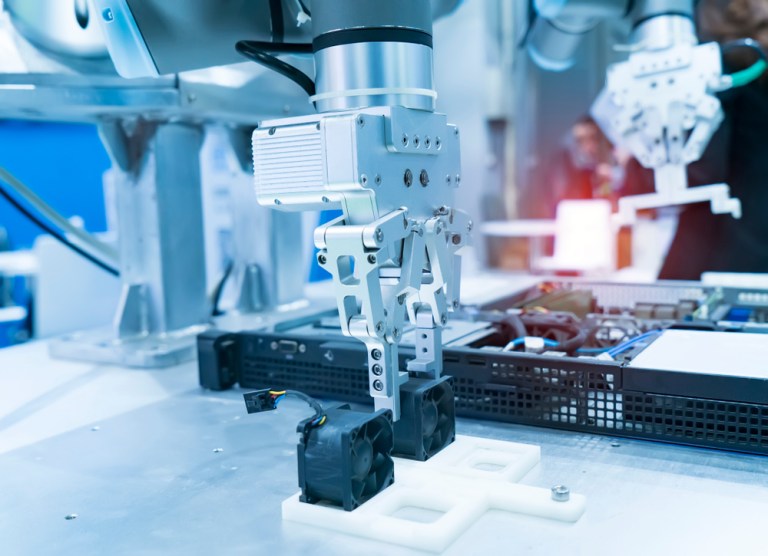
First, there was automation, then robotics process automation (RPA). As the enterprise makes its way through the Industry 4.0 age of automation and data sharing, analysts say there is yet another wave ahead, combining smart technologies to make businesses more efficient.
Industry 4.0 is the term given for the current trend of automation within the enterprise. Marked by robotics technologies, Internet of Things (IoT) and interconnected systems, this era of digitization has the potential to transform a businesses’ processes throughout the back office — but can just as easily overwhelm the enterprise struggling to upgrade systems and strategically choose which technologies to integrate.
Technological innovation waits for no one, though, and the next phase of the automation wave is here, according to NICE. The risk mitigation and fraud management firm has published a new paper with Deloitte Consulting, detailing the rise of Robotic and Cognitive Automation (R&CA), which is dubbed to be “the future of robotics process automation.”
In its “The Future of Operations — Moving Beyond Process Automation” report, NICE and Deloitte journey through the process of R&CA adoption and potential use cases for the technology. According to analysts, the “assumption” is that “many organizations are stumbling on a practical level to take the steps needed,” struggling to understand exactly what the technology is and how it can be used.
However, NICE VP of Advanced Process Automation Oded Karev says corporations are at least gearing up for disruption from R&CA.
“Many organizations today have employed a new executive titled ‘Automation Lead’ or ‘Innovation Lead,'” he told PYMNTS, noting that the role is designed to guide the enterprise’s adoption of R&CA technology throughout the company.
Existing interest in robotics is helping to fuel exploration of R&CA, added Karev. Indeed, earlier research from Deloitte found that 53 percent of surveyed executives say they have already begun the journey to research and adopt RPA, with 19 percent planning to do so in the coming two years. For nearly two-thirds, RPA adoption is a journey for the whole enterprise.
With RPA gaining traction, NICE noted that R&CA takes a step further with cognitive technology. That means business RPA adoption has already morphed into merely a “baseline” for stepping into robotics and cognitive automation.
Key to bridging RPA into R&CA is artificial intelligence (AI). Technological capabilities like decision-making and the ability to sense out new opportunities — and other human-like capabilities like “reading” and “listening” via automated data detection and biometrics — are key to R&CA. And while these capabilities sound futuristic, they are a reality today and can address points of friction throughout the enterprise, particularly when it comes to finance.
One use case, Karev explained, is invoice processing. As it currently stands, this is a “repetitive, time-consuming, error-prone task,” he said. “Handing it off to a robot would allow the human employee to tend to other activities which require strategic analysis.” Through the use of a tool like optical character recognition (OCR), one can process invoices and input data into the correct fields of a billing platform, he added.
NICE’s report also highlights the use case of opening a bank account. Instead of a prospective client calling or visiting a bank representative in person, manually finding personal information and sending in paper documents, R&CA can automate data entry and onboarding for banks, and can interface with the customer via intelligence tools like chatbots and automated background checks. Use of additional tools like OCR, machine learning algorithms, text analytics and natural language processing can be integrated into the account-opening process, too, to handle exceptions and automate the process from start to finish.
Increasing reliance on Big Data and automated tools coincides with raising cybersecurity concerns. Karev told PYMNTS that R&CA technologies can play a role in enterprises’ security strategies, too, supporting cyber investigators through automated data collection across enterprise systems and consolidating that information into a unified picture.
“Additionally,” he continued, “robots can monitor and collect information on actions which are executed or inputted as part of the cyber investigation process. By automating these activities, cyber investigators can handle more cases at any given time, with higher accuracy.”
The combination of automation and intelligence technologies, like OCR and machine learning, makes R&CA less of a trend and more of a way to overhaul and transform operations. The potential use cases of the technology, therefore, are vast. However, sespite the potential, corporates are struggling in many ways to embrace even the most basic forms of technology. At best, organizations are in the beginning of their automation journeys.
While R&CA takes a step further than RPA, even RPA can be a difficult sell for many organizations.
Deloitte acknowledged the risk of the “hype” effect that RPA may have on businesses, threatening to give rise to businesses that adopt the technology for the sake of it. Researchers at The Hackett Group have found that organizations struggle to identify which areas to automate when they want to embrace RPA, with the researchers warning of a “greater-than-expected learning curve.”
Despite interest in RPA, only 3 percent of organizations previously surveyed by Deloitte have scaled RPA to a level of 50 or more robots within their organizations. And an IT department, tasked with implementation and management of RPA, is actually least likely to embrace the technology, with only 31 percent of IT professionals supporting RPA initiatives (compared to 72 percent of C-Suite executives).
Without adoption of RPA as a baseline, embrace of R&CA is unlikely.
For those businesses that want to take the leap, however, NICE emphasized in its report that it is imperative for organizations to review data connectivity and availability, work with trusted advisors, and pilot a project to step into the worlds of RPA and cognitive technologies. According to analysts, organizations must embrace and engage with these innovations, despite their difficulties.
“Although we have ascertained that many employees desire change, a fundamental part of human nature may resist the very change that is desired,” the report stated.